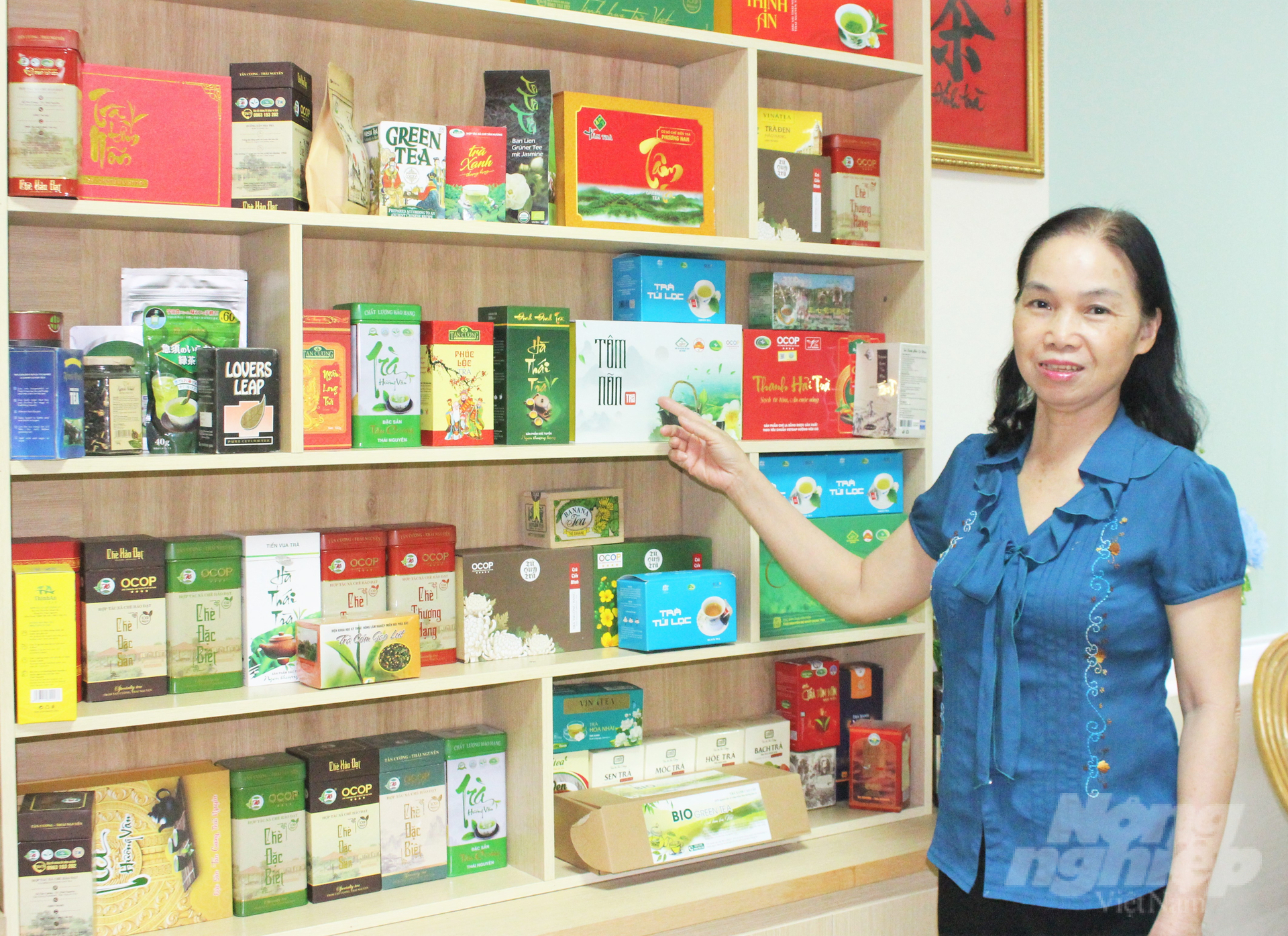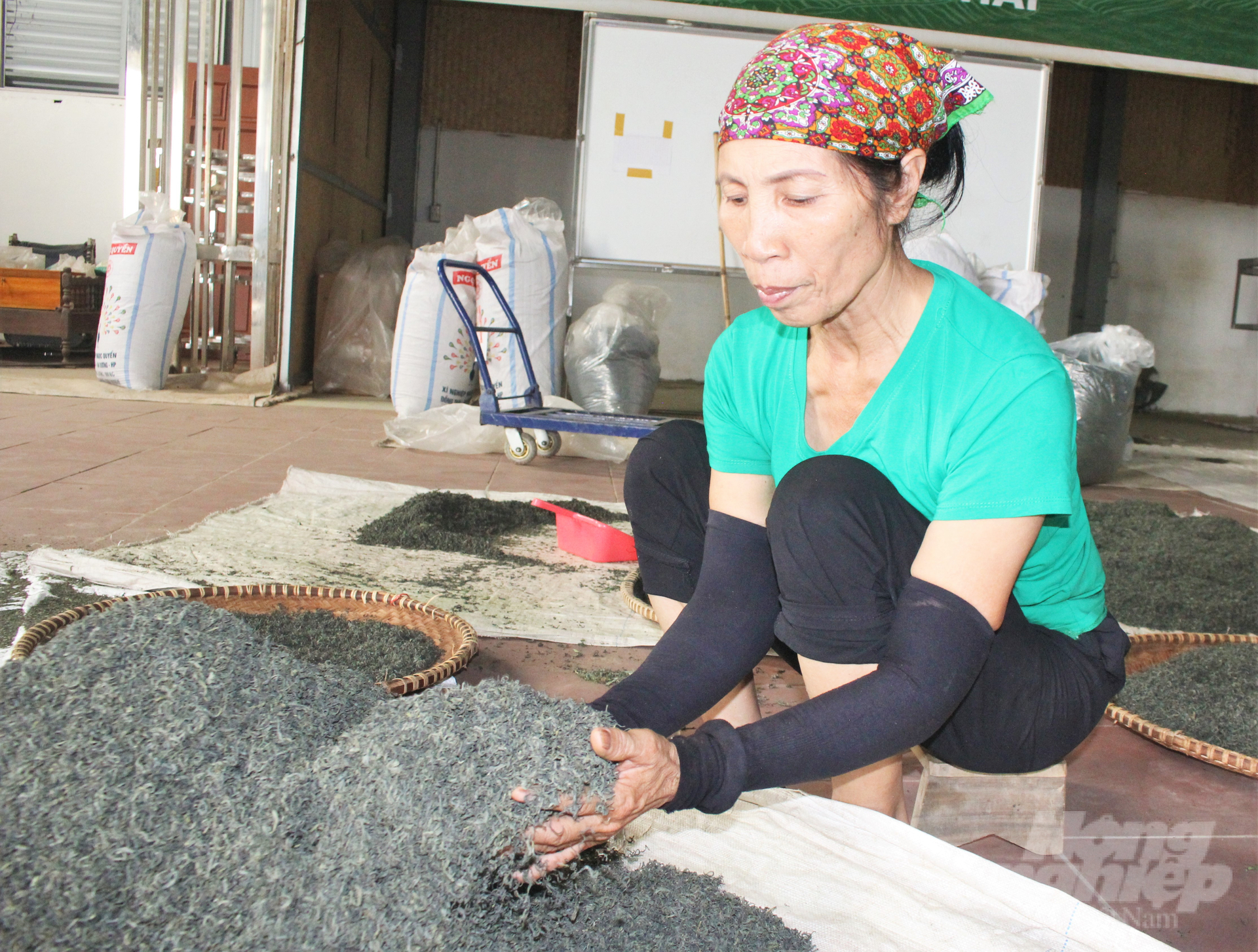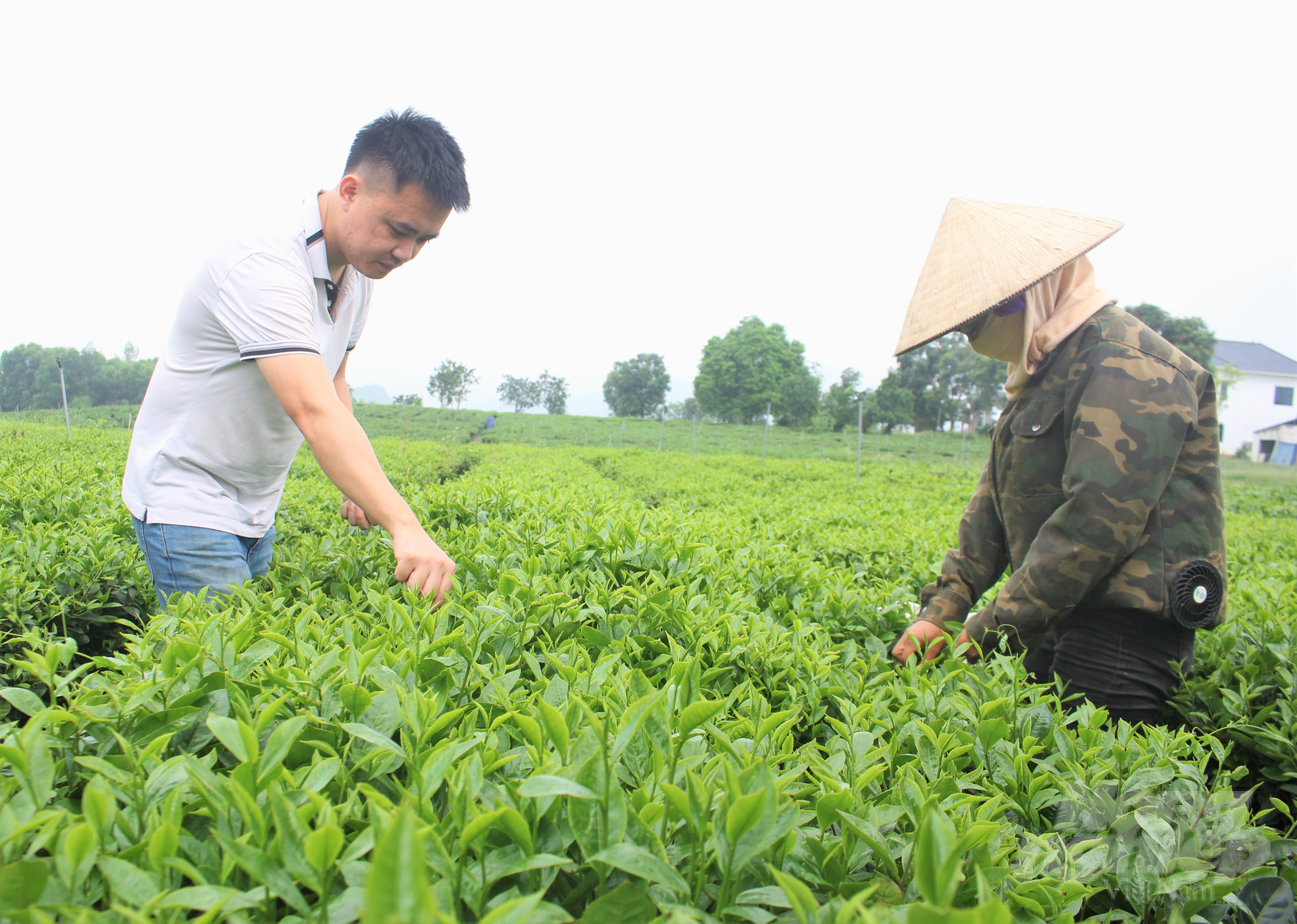June 19, 2025 | 01:23 GMT +7
June 19, 2025 | 01:23 GMT +7
Hotline: 0913.378.918
June 19, 2025 | 01:23 GMT +7
Hotline: 0913.378.918
Thai Nguyen province currently has over 22,000 hectares of tea, whereas the tea production area accounts for over 20,000 hectares. The output of fresh bud tea is over 260,000 tons, bringing in nearly 1,000 billion VND of revenue in 2022. Additionally, Thai Nguyen province has more than 4,000 hectares of VietGAP-certified tea, 11 hectares of UTZ-certified tea, 127 hectares of organic tea.
Ms. Nguyen Thi Nga, Chairwoman of Thai Nguyen Tea Association, attributed the growth in the province's tea industry to support policies by the local government and new tea varieties.
According to Ms. Nga, the province has deployed a comprehensive renovation of the tea industry with the "Project on the development of tea production, processing and consumption in Thai Nguyen province" since 2000. Accordingly, the province invested extensively in supporting to change the structure of tea varieties as well as the training of engineer specialists in order to provide local farmers with technical support. Households who grow new tea varieties will be supported with 60% of the variety price, 40% of the input material price. Additionally, seed nurseries are supported with cuttings.

Ms. Nguyen Thi Nga, Chairwoman of Thai Nguyen Tea Association, introducing the various local tea product lines. Photo: Trung Quan.
The province established the Thai Nguyen Province Tea Development Project Board in 2001. The Project Board employed twenty-five newly graduated agricultural engineers. Subsequently, the engineers were assigned to the Department of Agriculture and Rural Development receive training as tea specialists. After finishing their training program, the twenty-five specialists will be given permanent housing in tea production areas to directly assist farmers.
The local governments and the tea specialists will coordinate to educate local farmers on the need to convert from traditional low-yielding tea varieties to new tea varieties with higher yield and quality.
However, the conversion of tea varieties was challenged by deeply rooted tea production habits and practices. When the new tea varieties were originally introduced, the majority of local tea farmers expressed skepticism, with some vehemently protesting that they were familiar with the conventional production procedures while being perplexed by the new ones.
Undeterred, Ms. Nga and twenty-five diligent young engineers traveled to the Northern Mountainous Agriculture & Forestry Science Institute (NOMAFSI) in Phu Tho province to obtain new tea varieties such as LDP1, LDP2, Hung Dinh Bach, Kim Tuyen, Thuy Ngoc, Bat Tien, etc. for trial production. A series of five-hectare demonstration models were subsequently deployed as exhibition for local farmers.

New tea varieties accounted for 82% of Thai Nguyen province's variety structure by the end of 2022. Photo: Hoang Anh.
After two years, the first tea fields have shown noticeably different results. The tea trees started branching after an additional year and they were ready for harvest after 18 months. On the other hand, traditonal tea varities can only be harvested after at least three years. Consequently, tea farmers rushed to obtain and cultivate the new tea varieties, with the most prominent variety being the LDP1 hybrid. Most notably, the risk of losing midland tea varieties forced the province to decelerate the rapid conversion process.
Thai Nguyen's mission to propogate new tea varieties reached an important turn when the province guided farmers to establish an on-site seed nurseries instead of retrieving new varieties from Phu Tho province. Accordingly, the Thai Nguyen Province Tea Development Project Board received cuttings from NOMAFSI to provide to a small number of households, who will establish a pilot tea model in Thai Nguyen City. The model will be replicated in key districts within the province after succeeding.
However, tea production requires high technology, and several households reported heavy production losses. Consequently, Thai Nguyen Provincial People's Committee issued a policy to support cuttings for the first year. In addition, an agricultural extension team was assigned to train and provide technical support to tea farmers.
The yield gradually increased from 60 to 70, and then 80%. From a single seed nursery, the province expanded to house hundreds of high-quality nurseries.
The percentage of new tea varieties in Thai Nguyen province's variety structure reached approximately 20% by the end of 2005. Despite the relatively small volume, the acceptance of the tea new varieties by local farmers is nonetheless a success for the tea industry. Additionally, the new tea variety, including the hybrid variety, is completely suitable to the natural conditions of Thai Nguyen province.

Thanks to the new tea varieties, local farmers' income and livelihoods have improved significantly. Photo: Trung Quan.
Thai Nguyen province deployed the project on "Improving production value for the tea industry" between the year 2006 and 2010. Accordingly, the investment policy was strictly implemented to change the structure of tea varieties, with the primary variety being LDP1. At the end of the project, new tea varieties accounted for 50% of Thai Nguyen province's variety structure.
The province developed two projects from 2011 to 2015, and from 2016 to 2020, both of which featured a detailed roadmap for the development of the tea industry. Most notably, the project on "Improving added value in combination with developing Thai Nguyen tea brand" from 2016 to 2020 provided full support for new tea variety costs, with the goal of reaching 80% of Thai Nguyen province's variety structure.
The high quality tea varieties have diversified the Thai Nguyen tea product lines and increased production value. The average production value of Thai Nguyen reached over 124 million VND per hectare. Namely, the Tan Cuong tea production area has a production value of at least 200 million VND per hectare. The value of processed tea products in Thai Nguyen reached over 10,000 billion VND.
In addition to the domestic market, the "Thai Nguyen Tea" collective mark has received recognition in many countries around the world including the US, China, Taiwan, Russia, South Korea, Japan and so on.
“New tea varieties have helped Thai Nguyen tea industry quickly recover from its slump. Evidently, new tea varieties accounted for 82% of the province's variety structure by the end of 2022, with hybrid tea varieties accounting for 60%. The province has set a goal to bring this percentage to 85% by 2025, 90% by 2030 while retaining 10% of traditional midland tea varieties", shared Ms. Nga.
Dai Tu district in Thai Nguyen province has seen the most significant change in the structure of new tea varieties, with the new LDP1 variety covering the majority of the production area.
Ms. Nguyen Thi Hien, Chairman of the Board of Directors of Ha Thai Tea Joint Stock Company in Ha Thuong commune, Dai Tu district has had over 20 years of experience in exporting tea products.

New tea varieties are gradually replacing midland tea varieties in Thai Nguyen province. Photo: Hoang Anh.
According to Ms. Hien, the majority of local farmers concentrated on black tea production in the past. Desspite the excellent quality of Dai Tu's black tea, its export value is not worth the effort and expenses. Local businesses and farmers struggled to find a solution until they learned about the new tea varieties, which have completely renovated the local tea industry.
New varieties and farming techniques have diversified the local product lines, resulting in higher competitiveness. Farmers began producing green tea and high-grade green tea in addition to black tea for export.
Subsequently, the high quality tea material area was quickly formed. The company expanded its production linkages with households in La Bang, Tan Ninh, etc. on an area of 200 hectares. As a result, the company was able to process at least 20 different types of tea products. The company will continue to utilize raw materials to produce tea starch, cosmetics, medicinal herbs, shower gels, shampoos, cleaning detergents among many other proudcts.
Ms. Hien affirmed that organic tea is the only solution to improve production value. Moreover, new tea varieties play an extremely important role in the production of organic tea. Thanks to the high yield from new tea varieties, farmers will not hesitate to convert their production processes.
The tea produciton areas in Dong Hy district, Pho Yen city, Thai Nguyen province have seen significant changes over the years. For the locals, both the midland tea varities and new tea varieties, although differ in characteristics and yield, carry the soul of Thai Nguyen province.
Translated by Nguyen Hai Long
![Turning wind and rain into action: [9] Digitizing hydrometeorological data in response to climate change](https://t.ex-cdn.com/nongnghiepmoitruong.vn/608w/files/news/2025/06/17/z6704423696987_15fd32ffc26d590d204d520c9dac6786-nongnghiep-165943.jpg)
(VAN) Farmers have begun accessing hydrometeorological applications to adjust their cropping schedules, aiming to ensure productivity and adapt to climate change.
![Turning wind and rain into action: [8] Real-time salinity detection and early warning technology](https://t.ex-cdn.com/nongnghiepmoitruong.vn/608w/files/news/2025/06/17/z6704423696987_15fd32ffc26d590d204d520c9dac6786-nongnghiep-151127.jpg)
(VAN) Thanks to the integration of modern hydrological-hydraulic models, remote sensing technologies, and artificial intelligence, the accuracy of hydrological forecasting has significantly improved.
![Turning wind and rain into action: [7] Early disaster warnings help marine farmers minimize losses](https://t.ex-cdn.com/nongnghiepmoitruong.vn/608w/files/news/2025/06/17/z6704423696987_15fd32ffc26d590d204d520c9dac6786-nongnghiep-142942.jpg)
(VAN) In recent years, thanks to early disaster warnings and forecasting, marine farmers in Khanh Hoa province have been able to reduce risks and losses, thereby improving production efficiency.
![Turning wind and rain into action: [6] ‘Four on-the-spot’ disaster management software](https://t.ex-cdn.com/nongnghiepmoitruong.vn/608w/files/news/2025/06/17/e5a48259d6a262fc3bb3-nongnghiep-183800.jpg)
(VAN) By simply activating the scenario on the disaster management software, the relevant authorities immediately know how many households need to be evacuated, where to evacuate them to, and by what means of transportation…
![Turning wind and rain into action: [5] Hue applies modern technology in disaster forecasting](https://t.ex-cdn.com/nongnghiepmoitruong.vn/608w/files/news/2025/06/17/z6704423696987_15fd32ffc26d590d204d520c9dac6786-nongnghiep-093938.jpg)
(VAN) In Hue city, modern technology has recently been applied in meteorological and hydrological forecasting and warning, helping to reduce the damage caused by natural disasters.

(VAN) A cutting-edge farming technique being implemented on an experimental ranch in Arizona's Sonoran Desert has already saved a billion gallons of water over five years, according to Civil Eats.

(VAN) Poultry and pig production and the environment can be boosted through enhanced water technology, according to new research.